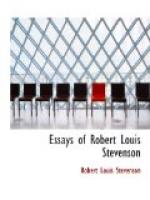II
PERSONALITY AND CHARACTER
Stevenson had a motley personality, which is sufficiently evident in his portraits. There was in him the Puritan, the man of the world, and the vagabond. There was something too of the obsolete soldier of fortune, with the cocked and feathered hat, worn audaciously on one side. There was also a touch of the elfin, the uncanny—the mysterious charm that belongs to the borderland between the real and the unreal world—the element so conspicuous and so indefinable in the art of Hawthorne. Writers so different as Defoe, Cooper, Poe, and Sir Thomas Browne, are seen with varying degrees of emphasis in his literary temperament. He was whimsical as an imaginative child; and everyone has noticed that he never grew old. His buoyant optimism was based on a chronic experience of physical pain, for pessimists like Schopenhauer are usually men in comfortable circumstances, and of excellent bodily health. His courage and cheerfulness under depressing circumstances are so splendid to contemplate that some critics believe that in time his Letters may be regarded as his greatest literary work, for they are priceless in their unconscious revelation of a beautiful soul.
Great as Stevenson was as a writer, he was still greater as a Man. So many admirable books have been written by men whose character will not bear examination, that it is refreshing to find one Master-Artist whose daily life was so full of the fruits of the spirit. As his romances have brought pleasure to thousands of readers, so the spectacle of his cheerful march through the Valley of the Shadow of Death is a constant source of comfort and inspiration. One feels ashamed of cowardice and petty irritation after witnessing the steady courage of this man. His philosophy of life is totally different from that of Stoicism; for the Stoic says, “Grin and bear it,” and usually succeeds in doing neither. Stevenson seems to say, “Laugh and forget it,” and he showed us how to do both.
Stevenson had the rather unusual combination of the Artist and the Moralist, both elements being marked in his writings to a very high degree. The famous and oft-quoted sonnet by his friend, the late Mr. Henley, gives a vivid picture:
“Thin-legged, thin-chested, slight
unspeakably,
Neat-footed and weak-fingered: in
his face—
Lean, large-honed, curved of beak, and
touched with race,
Bold-lipped, rich-tinted, mutable as the
sea,
The brown eyes radiant with vivacity—
There shown a brilliant and romantic grace,
A spirit intense and rare, with trace
on trace
Of passion, impudence, and energy.
Valiant in velvet, light in ragged luck,
Most vain, most generous, sternly critical,
Buffoon and poet, lover and sensualist;
A deal of Ariel, just a streak of Puck,
Much Antony, of Hamlet most of all,
And something of the Shorter Catechist.”




